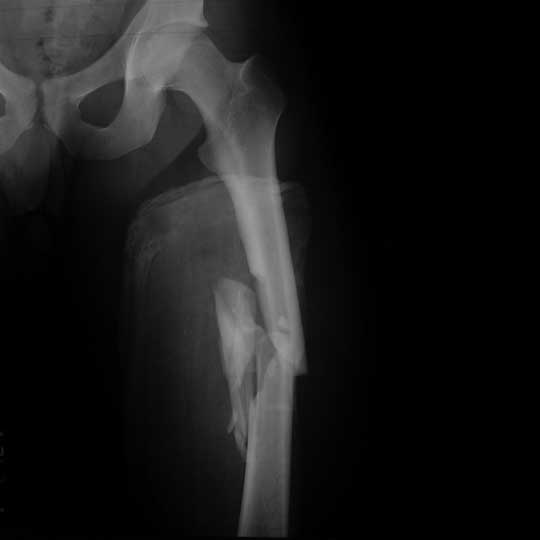|




|
synonyms: Femoral Fracture, femur fracture
Femoral Shaft Fracture ICD-10
Femoral Shaft Fracture ICD-9
- 821.01(closed)
- 821.11(open)
Femoral Shaft Fracture Etiology / Epidemiology / Natural History
- Femoral shaft fracture = fracture of the femoral diaphysis occurring in the area between 5cm distal to the lesser trochanter and the adductor tubercle.
Femoral Shaft Fracture Anatomy
Femoral Shaft Fracture Clinical Evaluation
- ATLS resuscitation. These can be high enegery injuries, assessment should begin with the A,B,C's.
- Obvious deformity of thigh often with limb shortening
- Document neurovascular exam before and after any treatment.
- Evaluate for hemarthrosis: indicates associated meniscal tear or knee ligamentous injury.
Femoral Shaft Fracture Xray
- A/P and lateral views of femur. High quality A/P and lateral views of the hip and knee are indicated to r/o associated injuries, especially femoral neck fractures. Internal rotation hip films often beneficial. (Tornetta P, JBJS 2007;89A:39).
- CT: consider fine cut CT through the femoral neck if concern for associated femoral neck fracture (Tornetta P, JBJS 2007;89A:39).
Femoral Shaft Fracture Classification/Treatment
- Multi-trauma, Unstable patient (hypotensive, elevated lactate, base deficit, pulmonary injury, brain injury:
-Treatment = ATLS resuscitation, Femoral Shaft External Fixation 20690, delayed definitive fixation (IM nail). (Pape HC, J Trauma 2002;53:452), Morshed S, JBJSAm 2009; 91(1):3-13).
- Multi-trauma, Stable patient (ipsilateral femur/tibia,ipsilateral femur/femoral neck, ipsilateral femur/acetabulum)
-Treatment = ATLS resuscitation, Femoral Shaft Retrograde Nail 27506.
- Obesity
-Treatment = ATLS resuscitation, Femoral Shaft Retrograde Nail 27506l.
- Stable patient, Isolated femoral shaft fracture
-Treatment = ATLS resuscitation, Femoral Shaft Antegrade Nail 27506.
- Open Grades I, II, & IIIA femur fracture
-Treatment = IM nailing (Lhowe DW, JBJS 1988;70A: 812-820).
- Open Grade III B & C injuries with extensive contamination or neuro-vascular injury
-Consider Femoral Shaft External Fixation 20690.
- Gunshot wounds: femur fx’s associated with low to medium velocity gunshot wounds should be treated with immediate debridement, static locked intramedullary nailing and 48hrs of IV antibiotics. Delayed fixation and proximal tibial traction may be necessary if there is severe contamination and evidence of major devitalization or in shot-gun wounds. (Wright DG, J Trauma 1993;35:678) (Nowotarski P, J Orthop Trauma 1994;8:134) (Bergman M, J Trauma 1993;34:783)
- Bilateral femoral shaft fracture
-26% mortality rate (Copelenad, CE, JOT 1998;12:315).
-Increased risk of pulmonary dysfuction, ARDS, compartment syndrome, pernoeal nerve palsy, nonunion
-Treatment = Femoral Shaft External Fixation 20690 with delayed conversion to bilateral reamed Femoral Shaft Retrograde Nail 27506l.
- AO Classification AO Classification
- Winquist Classification-catagorized by comminution. 1=only small piece of bone broken away. 2=a larger butterfly fragment, but at least 50% cortex intact. 3=large butterfly fragment precluding control of length, rotation or both. 4=severe comminution with no abutment of cortices at the level of fx to prevent shortening
Femoral Shaft Fracture Associated Injuries / Differntial Diagnosis
- Multiply injured patient: Consider temporary external fixation for multiple injured patients. (Scalea TM, J Trauma 2000;48:613-623)
- thoracic/pulmonary injury: is not a contraindication to IM nailing. (Bosse MJ, J Bone Joint Surg 1997;79A:799-809.) Boulanger BR, J Trauma 1997;43:24-28)
- Closed Head Injury: Delayed fracture fixation (after 24 to 48 hours) may be the best alternative. Acute fracture fixation may lead to large fluid shifts or hypotension, and should be avoided in a patient who has severe brain injuries. Consider external fixation (Townsend RN, J Trauma 1998;44:977-982)(Jaicks RR, J Trauma 1997;42:1-5)
- Femoral Neck Fracture: 3%-5% of femoral shaft fractures will have associated femoral neck fractures. High quality xrays of the hip are indicated for all patients with femoral shaft fractures. (Swiontkowchi MF, JBJS 1994;76A:129)
- Meniscal tear
- Knee ligmanetous injury: ACL / MCL / LCL / PCL / PLC.
Femoral Shaft Fracture Complications
- Infection-0.9%
- Nonuion=0.9%
- Malunion(rotation,shortening,angulation) rotational difference > 15 degrees from unaffected side is a true malrotation deformity. Hip and knee symptoms and functional disability occur when rotation is >20 degrees. Rotational differences <10 degrees seldom produce symptomatic disability.
- Peroneal nerve palsy
- Fat-embolism sydrome
- ARDS
- DVT / PE
- Pudendal Nerve palsy: compression of the pudendal nerve from traction against the perineal post on the fracture table in the supine position can lead to perineal numbness following intramedullary nailing. Attention to detail in placement of the patient and adequate padding can minimize this risk. (Brumback RJ,.JBJS 1992;74A:1450-1455)
- DIC
- Compartment Syndrome
- Heterotopic Ossification
- Knee pain (retrograde nail)
- Thigh pain (antegrade nail)
- Abductor lurch (antegrade nail)
Femoral Shaft Fracture Follow-up Care
Femoral Shaft Fracture References
|




